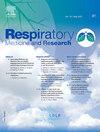窄带成像在评估COVID-19患者支气管粘膜血管增生中的作用。
IF 1.8
4区 医学
Q3 RESPIRATORY SYSTEM
引用次数: 0
摘要
背景:以肺血管为靶点的SARS-CoV-2病毒被认为同时影响肺动脉和支气管动脉。本研究对COVID-19肺炎住院患者的气管支气管血管密度进行窄带成像(NBI)观察。为了确定观察到的变化是否是COVID-19患者特有的,该程序也在非COVID-19患者中进行。方法:在这项单中心前瞻性研究中,30例患者同时使用白光和NBI进行了支气管镜检查,其中10例为COVID-19感染,10例为非COVID-19肺部感染,10例为外周肺结节。NBI观察气管支气管血管密度由两名盲法肺学家按三个水平(隆突、右主支气管和左主支气管)进行评分。结果:与其他两组相比,COVID-19患者的气管支气管血管化明显增加。NBI获得的气管支气管血管化中位整体评分(总分15分)为:COVID-19组为10[9 - 13],非COVID-19组为5 [4 - 10](p < 0.001),结节组为6 [4 - 9](p = 0.002)。使用加权的Cohen’s Kappa系数,我们观察到两个评分者对气管支气管血管化评分的评价具有良好的一致性(κ = 0.75 [0.65-0.83]);P < 0.001)。结论:NBI支气管镜下新冠肺炎患者气管支气管血管化表现为弥漫性改变。我们认为,这种伴有血管扩张的支气管血管亢进至少在一定程度上导致了肺内右至左分流,这是COVID-19相关急性血管窘迫综合征(AVDS)的特征。本文章由计算机程序翻译,如有差异,请以英文原文为准。
Role of narrow band imaging in assessing bronchial mucosal hypervascularization in COVID-19 patients
Background
SARS-CoV-2 virus which targets the lung vasculature is supposed to affect both pulmonary and bronchial arteries. This study evaluated the tracheobronchial vascularization density observed with narrow band imaging (NBI) in patients hospitalized for COVID-19 pneumonia. To determine if the observed changes were specific of COVID-19 patients, the procedure was also performed in non-COVID-19 patients.
Methods
Thirty patients included in this monocentric, prospective study underwent videobronchoscopy using both white light and NBI: 10 with a COVID-19 infection, 10 with a non-COVID-19 pulmonary infection and 10 with a peripheral pulmonary nodule. The tracheobronchial vascular density observed through NBI was rated by two blinded pneumologists at three levels (carina, right main bronchus and left main bronchus).
Results
When compared to the two other groups, a significant increase of the tracheobronchial vascularization was found in COVID-19 patients. The median tracheobronchial vascularization global score obtained with NBI (out of 15 points) was: 10 [9 – 13] in the COVID-19 group, 5 [4 – 10] in the non-COVID-19 group (p < 0.001) and 6 in the Nodule group [4 – 9] (p = 0.002). Using a weighted Cohen's Kappa coefficient, we observed a good agreement between the two raters for the evaluation of the tracheobronchial vascularization score (κ = 0.75 [0.65–0.83]); p < 0.001).
Conclusion
Videobronchoscopy with NBI in COVID-19 patients showed diffuse changes in tracheobronchial vascularization. We suggest that such bronchial hypervascularisation with dilated vessels contributes, at least in part, to the intrapulmonary right to left shunt that characterized the COVID-19 related Acute Vascular Distress Syndrome (AVDS).
求助全文
通过发布文献求助,成功后即可免费获取论文全文。
去求助
来源期刊

Respiratory Medicine and Research
RESPIRATORY SYSTEM-
CiteScore
2.70
自引率
0.00%
发文量
82
审稿时长
50 days
 求助内容:
求助内容: 应助结果提醒方式:
应助结果提醒方式:


